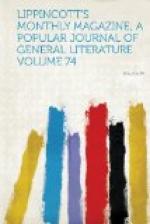Lady Belvedere passed the rest of her days in peace and comfort at the house of her daughter and son-in-law, Lord and Lady Lanesborough. She did not long survive her husband, and on her deathbed, after partaking of the holy communion, affirmed with a most solemn oath her perfect innocence of the crime for which she had suffered so much.
But perhaps in many respects Charlemont House has the most interesting recollections connected with it of all the grand-seigneur mansions of the Irish metropolis. It was here that the first earl of Charlemont, the best specimen of a nobleman that Ireland has to boast of, passed the greater portion of his later life. Lord Charlemont’s name is to be found in all the memoirs of eminent political and literary men of his time. He was the friend of Burke and Johnson, a popular member of the club, and a munificent patron of literature and art. But more than all this, he stuck bravely to his country, and to no man in Ireland did the Stopford motto, Patriae infelici fidelis, more correctly apply. Had more of his order been like him, what a different country might Ireland have been!
I found Charlemont House full of painters and glaziers. The mansion, which was retained in statu quo by the late earl, although, for fifty years no member of the family had slept there, has now been sold to the government, and is being prepared for the accommodation of the survey department. The mouldings of the beautiful ceilings are still extant in some of the rooms, although what once was gilt is now white-wash. The library is much as it was, minus the very valuable collection of books, which were sold some time since by the present earl, and fetched a large sum, albeit many of the most valuable were destroyed in a fire which broke out at the auctioneer’s where they were deposited in London.[3]
With his friend Edmund Burke, Lord Charlemont maintained a close correspondence. One of Burke’s published letters relates to an American gentleman, Mr. Shippen, whom he was introducing to the hospitalities of Charlemont House, and whom he describes as very agreeable, sensible and accomplished. “America and we,” he concludes, “are not under the same crown, but if we are united by mutual good-will and reciprocal good offices, perhaps it may do almost as well. Mr. Shippen will give you no unfavorable specimen of the New World.”
From the middle of the last century Henrietta street,[4] on the north bank of the Liffey, was the residence of many of the leading members of the aristocracy. The street is a cul-de-sac, with the King’s Inn (the Temple and Lincoln’s Inn of Dublin) at the farther end. The houses are extremely spacious and richly ornamented; in fact, far finer in point of proportion and design than ordinary London houses of the first class.




